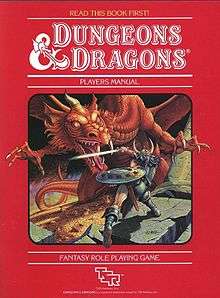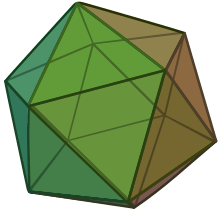Dungeons & Dragons Basic Set
|
Dungeons & Dragons 1977 Basic Set boxart | |
| Author |
Based on the work of Gary Gygax and Dave Arneson J. Eric Holmes (1977 version) Tom Moldvay (1981 version) Frank Mentzer (1983 version) Troy Denning (1991 version) |
|---|---|
| Genre | Role-playing game |
| Publisher | TSR, Inc. |
Publication date | 1977, 1981, 1983, 1991 |
| Media type | Boxed set |
The Dungeons & Dragons Basic Set is a set of rulebooks for the Dungeons & Dragons (D&D) fantasy role-playing game. First published in 1977, it saw a handful of revisions and reprintings. The first edition was written by J. Eric Holmes based on Gary Gygax and Dave Arneson's original work. Later editions were edited by Tom Moldvay, Dave Cook, and Frank Mentzer.
The Basic Set details the essential concepts of the D&D game. It gives rules for character creation and level-advancement for player characters of levels 1–3. It also includes information on how to play adventures inside dungeons for both players and the Dungeon Master.
1977 version
The original Dungeons & Dragons Basic Set (TSR 1001) was published by TSR, Inc. in 1977.[1]
TSR hired outside writer John Eric Holmes to produce the Basic Set as an introductory version of the D&D game. It incorporates concepts from the original 1974 D&D boxed set plus the Supplement I: Greyhawk.[2] The rulebook covers characters of levels one through three, rules for adventuring in dungeons, and introduces the concepts of the game, and explained the game's concepts and method of play in terms that made it accessible to new players ages twelve and above who might not be familiar with tabletop miniatures wargaming. Although the Basic Set was not fully compatible with Advanced Dungeons & Dragons, players were expected to continue play beyond third level by moving to AD&D,[2][3] which began to be released later that year. Holmes preferred a lighter tone with more room for personal improvisation, while Gary Gygax, who wrote the advanced game, wanted an expansive game with rulings on any conceivable situation which might come up during play, a document which could be used to arbitrate disputes at tournaments.[2]
The first Basic Set was available as a 48-page stand-alone rulebook featuring artwork by David C. Sutherland III, or as part of a boxed set, which was packaged in a larger, more visually appealing box than the original boxed set, allowing the game to be stocked on retail shelves and targeted at the general public via toy stores.[4] The boxed set included a set of polyhedral dice and supplemental materials.[2] In that same year, Games Workshop (U.K.) published their own version of the rulebook, with a cover by John Blanche, and illustrations by Fangorn.[2] Supplemental materials appearing in the boxed set included geomorphs, monster and treasure lists, and a set of polyhedral dice.[5]
For a period in 1979, TSR experienced a dice shortage. Basic sets published during this time frame came with two sheets of numbered cutout cardstock chits that functioned in lieu of dice, along with a coupon for ordering dice from TSR.[6] The rulebook also included a brief sample dungeon with a full-page map. Starting with the fourth printing in 1978, the two booklets of maps, encounter tables, and treasure lists were replaced with the module B1 In Search of the Unknown;[2] printings six through eleven (1979–1982) featured the module B2 The Keep on the Borderlands instead.[2]
1981 revision

After the release of the AD&D game, the Basic Set saw a major revision in 1981 by editor Tom Moldvay.[2] The game was not brought in line with AD&D but instead further away from that ruleset, and thus the basic D&D game became a separate and distinct product from TSR’s flagship game AD&D. The former was promoted as a continuation of the tone of original D&D, while AD&D was an advancement of the mechanics.[7]
The revised version of the set included a larger, sixty-four page rule book with a red border and a color cover by Erol Otus, the module B2 The Keep on the Borderlands, six polyhedral dice,[2] and a marking crayon.[6] The book was predrilled for use in a three-ringed binder, and the complete set of miniature polyhedral dice came in a heat-sealed bag with a small black wax crayon to use in marking the dice.[8] Cardboard chits were briefly included in place of dice when TSR's source dried up.[2]
With the revision of the Basic Set, discrete rulesets for higher character levels were introduced as expansions for the basic game.[9] The Moldvay Basic Set was immediately followed by the accompanying release of an Expert Set edited by Dave Cook that supported character levels four through fourteen, with the intent that players would continue with the Expert Set.[2][10] The revised rulebooks were visually distinct from the original rules: the Holmes booklet had a blueprint-style pale blue cover, while the Moldvay Basic Set and Cook Expert Set booklets had bright red and blue covers, respectively.[11]
1983 revision

In 1983, the Basic Set was revised again, this time by Frank Mentzer, and redubbed Dungeons & Dragons Set 1: Basic Rules. The set included a sixty-four page Players Manual,[12] a forty-eight page Dungeon Masters Rulebook,[12] six dice,[2] and in sets in which the dice were not painted, a crayon.[6] The 1983 revision was packaged in a distinctive red box, and featured cover art by Larry Elmore.[2] Between 1983 and 1985, the system was revised and expanded by Mentzer as a series of five boxed sets, including the Basic Rules (red cover), Expert Rules (blue),[13] Companion Rules (teal, supporting levels fifteen through twenty-five),[14] Master Rules (black, supporting levels twenty-six through thirty-six),[15] and Immortal Rules (gold, supporting Immortals, characters who had transcended levels).[16] Instead of an adventure module, the Basic Set rulebooks included a solo adventure and an introductory scenario to be run by the Dungeon Master.[2]
The rules for the game were little changed from the Moldvay set, but the presentation was overhauled into a more tutorial form, to make the game easier for younger players to learn.[17]
The 10th Anniversary Dungeons & Dragons Collector's Set boxed set, published by TSR in 1984, included the rulebooks from the Basic, Expert, and Companion sets; modules AC2, AC3, B1, B2, and M1 Blizzard Pass; Player Character Record Sheets; and dice. This set was limited to a thousand copies, and was sold by mail and at GenCon 17.[2]:147
An Australian version of the Basic Set was printed by Jedko Games in 1987.[2]
1991 revision
In 1991, TSR released a replacement for the Basic Set labelled as The New Easy-to-Master Dungeons & Dragons Game, and known as the "Black Box". This version, principally designed by Troy Denning, made very few changes to the game, but introduced a card-based tutorial system for new players, inspired by the SRA reading program, and included support for characters up to fifth level, instead of the third level limit of prior Basic Set versions.[18] The Dungeons & Dragons Rules Cyclopedia was published by TSR the same year, compiling and revising the rules from the Basic, Expert, Companion, and Master Rules box sets to allow players to continue beyond the Black Box.[18] Later printings of the Black Box bore the title Classic Dungeons & Dragons.
Reception
Clayton Miner reviewed the 1981 version of the Basic Set for Pegasus magazine #1 (1981).[8] Miner felt that "this product offers the purchaser a bit more for their money than did the first basic set", noting that the inclusion of the adventure module was an improvement over the dungeon geomorphs from the previous set, and commented that "this package will keep the new gamer interested and enthused for a number of adventures" even if Keep on the Borderlands "holds little challenge for the experienced gamer".[8] He criticized the artwork in the rule book, calling it "below standard" and expressed hope that the artwork in the then-upcoming D&D Expert Set would be better.[8] Aside from this, he commented that "the book is a vast improvement over the earlier version. Better organization and well written rules are the main features of this edition.[8]
Doug Cowie reviewed the 1983 version of the Basic Set for Imagine magazine and gave it a quite positive review.[12] He noted that it was not just a money-making scheme on the part of the publisher, trying to sell a new game to existing players. According to Cowie, while the rules stay the same, thus allowing those with the older version to continue using their sets, the presentation has changed. He approved of the fact that "at long last",[12] a game company released a product that explains to someone new to role-playing games how to get started. He also praised the "vastly improved"[12] cover art and interior illustrations, but noted that the box contains a set of "dreadful TSR dice".[12] Cowie ended his review by stating that "Basic is a lot closer to the spirit of the original game than is the rambling, unwieldy and sometimes pompous Advanced" and that "for one-off dungeon type games I would recommend Basic to anyone, beginner and veteran alike."[12]
References
- ↑ "The History of TSR". Wizards of the Coast. Archived from the original on 2008-10-04. Retrieved 2005-08-20.
- 1 2 3 4 5 6 7 8 9 10 11 12 13 14 15 16 Schick, Lawrence (1991). Heroic Worlds: A History and Guide to Role-Playing Games. Prometheus Books. pp. 130–131. ISBN 0-87975-653-5.
- ↑ Gygax & Arneson (1977) p. 6. states "...experience levels that high are not discussed in this book and the reader is referred to the more complete rules in Advanced Dungeons & Dragons"
- ↑ Tresca, Michael J. (2010), The Evolution of Fantasy Role-Playing Games, McFarland, p. 63, ISBN 078645895X
- ↑ Turnbull, Don (December 1978 – January 1979). "Open Box: Players Handbook". White Dwarf (review). Games Workshop (10): 17.
- 1 2 3 "D&D Basic Set". The Acaeum. Retrieved 2011-10-08.
- ↑ Gygax, Gary (June 1979). "D&D, AD&D and Gaming". The Dragon #26. TSR. III (12): 29–30. ISSN 1062-2101.
- 1 2 3 4 5 Miner, Clayton (1981). "D&D Basic Set". Pegasus (review). Judges Guild (1): 85.
- ↑ Gygax, Gary (December 1978). "Dungeons & Dragons: What Is It and Where Is It Going?". The Dragon #21. TSR. III (8): 29–30. ISSN 1062-2101.
- ↑ Gygax, Gary, and Dave Arneson [1974], edited by Dave Cook. Dungeons & Dragons Expert Set (TSR, 1981)
- ↑ "D&D Clones!". White Dwarf. Games Workshop (24): 29. April–May 1981.
- 1 2 3 4 5 6 7 Cowie, Doug (October 1983). "Game Reviews". Imagine (review). TSR Hobbies (UK), Ltd. (7): 42.
- ↑ Gygax, Gary, and Dave Arneson [1974], edited by Frank Mentzer. Dungeons & Dragons Set 2: Expert Rules (TSR, 1983)
- ↑ Mentzer, Frank. Dungeons & Dragons Set 3: Companion Rules (TSR, 1984)
- ↑ Gygax, Gary, Frank Mentzer. Dungeons & Dragons Set 4: Master Rules (TSR, 1985)
- ↑ Mentzer, Frank. Dungeons & Dragons Set 5: Immortal Rules (TSR, 1986)
- ↑ Appelcline, Shannon. "D&D Basic Set - DM's Rulebook (BECMI ed.) (Basic)". dndclassics.com. Retrieved June 26, 2015.
- 1 2 Shannon Appelcline. "D&D Rules Cyclopedia (Basic)". dndclassics.com. Retrieved September 9, 2014.
Reviews: Different Worlds #12 (1981), Different Worlds #34 (1984), Dragon #84 (1984)

